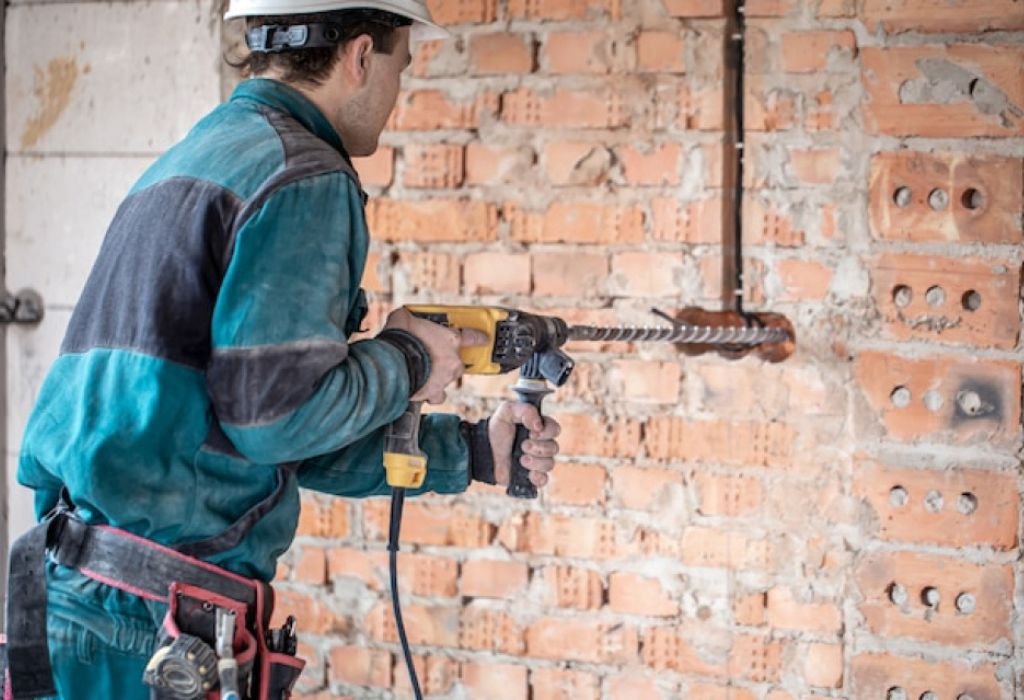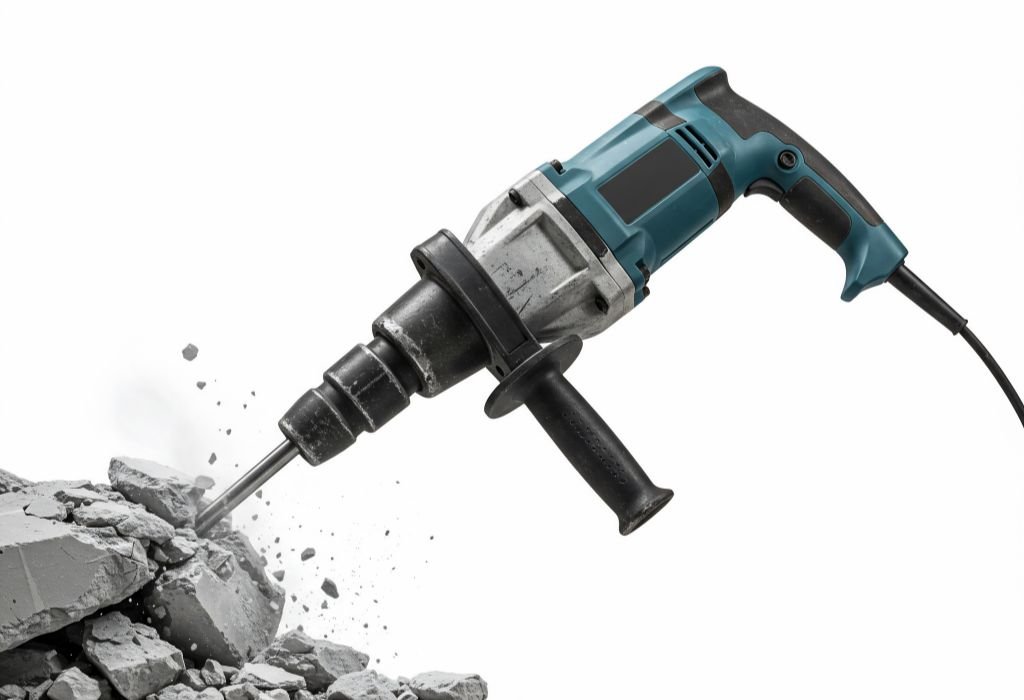A homeowner faces an old concrete patio that needs to be removed. Swinging a sledgehammer feels exhausting, and the thought of chipping away by hand seems endless.
At this point, the question arises: can a rotary hammer break concrete effectively?
The answer is yes, but with important limitations. Rotary hammers are designed to drill, chip, and break lighter to medium concrete.
For heavy demolition, a jackhammer may still be needed. Choosing the right tool saves both time and effort.
Concrete is one of the most durable building materials, and breaking it requires significant impact energy. According to the Portland Cement Association, over 400 million cubic yards of concrete are produced each year in the U.S..
With so much concrete used in driveways, slabs, and walls, finding efficient ways to remove it has become essential for DIYers and professionals alike.
This guide explains how rotary hammers work, their strengths, limits, safety tips, and when to use them instead of larger demolition tools.
By the end, you’ll know exactly if a rotary hammer is right for your concrete project.
What Is a Rotary Hammer?

A rotary hammer is a power tool designed for drilling and chiseling hard materials. It uses a piston mechanism that delivers powerful hammering action while the bit rotates. This makes it stronger than a standard hammer drill.
Rotary hammers are available in corded and cordless models, with SDS, SDS-Plus, and SDS-Max shank systems. The larger the shank, the more impact energy the tool delivers. They are commonly used for drilling anchor holes, breaking small slabs, or removing tiles.
Is a rotary hammer different from a hammer drill?
Yes, it uses a piston mechanism, while a hammer drill relies on a mechanical clutch.
Can it be used on wood or metal?
Not ideal—rotary hammers are made for masonry and concrete.
What bits are compatible with rotary hammers?
They use SDS, SDS-Plus, or SDS-Max bits depending on the tool size.
Does it have multiple modes?
Yes, most models offer drilling, hammer drilling, and chiseling modes.
Can a Rotary Hammer Break Concrete?
Yes, a rotary hammer can break concrete, but mainly in light to medium applications. It works well for wall sections, thin slabs, and surface chipping. For thick foundations or reinforced concrete, a demolition hammer or jackhammer is better suited.
The impact energy rating (measured in joules) determines how effective the rotary hammer will be. SDS-Plus hammers are suitable for smaller jobs, while SDS-Max tools can handle more demanding concrete breaking tasks.
Can it break a driveway?
Yes, but only thinner slabs. Thick driveways require heavier tools.
Can it handle reinforced concrete?
It struggles with heavy rebar but can chip around smaller reinforcement.
What depth can it handle?
Usually up to 4–6 inches of concrete, depending on the hammer size.
Is it faster than manual tools?
Yes, significantly faster and less tiring than a sledgehammer.
Rotary Hammer vs Demolition Hammer
A rotary hammer is versatile, while a demolition hammer is designed purely for breaking. Demolition hammers deliver more impact energy, making them better for large slabs and foundations.
If the project involves both drilling and light breaking, a rotary hammer is ideal. If it’s only heavy demolition, a demolition hammer is the better choice.
Which is lighter?
Rotary hammers are lighter and easier to handle.
Which delivers more power?
Demolition hammers provide much higher impact energy.
Which is better for home projects?
Rotary hammers are more practical for DIY tasks.
Which tool lasts longer under stress?
Demolition hammers are built for continuous heavy use.
Best Uses of a Rotary Hammer on Concrete
Rotary hammers shine in tasks that involve both drilling and chipping. Common uses include breaking small concrete pads, removing tiles, or enlarging holes. They are also excellent for chipping away sections of walls or driveways for repairs.
For professional contractors, rotary hammers save time during renovations. For homeowners, they provide an accessible solution for smaller demolition tasks without renting larger tools.
Can it remove tiles?
Yes, it’s one of the best tools for tile removal.
Can it help in wall demolition?
Yes, especially for interior concrete or block walls.
Is it useful for driveway repairs?
Yes, but only for chipping or removing sections, not full demolition.
Can it prepare surfaces for new work?
Yes, it can roughen concrete surfaces before resurfacing.
Limitations of Using a Rotary Hammer
Despite its power, a rotary hammer is not a full replacement for a jackhammer. It has limited capacity against thick, reinforced concrete. Prolonged use on large projects can also wear out the tool quickly.
Another limitation is user fatigue. Although lighter than demolition hammers, rotary hammers still vibrate heavily. Extended use requires breaks to reduce strain.
Is it good for large slabs?
No, it’s better for smaller sections.
Does it work well with rebar?
Not efficiently, rebar slows the breaking process.
Is it suitable for commercial demolition?
Only for light-duty tasks, not major jobs.
Can it run continuously?
It’s not designed for nonstop use like larger demolition tools.
Safety Tips for Breaking Concrete with a Rotary Hammer

Breaking concrete creates dust, flying debris, and vibrations. Proper safety gear and handling are essential. Always wear safety glasses, ear protection, gloves, and a dust mask.
Using vibration-reducing handles and taking regular breaks helps prevent fatigue. Keep the tool bit sharp for maximum efficiency.
Do you need safety glasses?
Yes, to protect from flying debris.
Is hearing protection required?
Yes, rotary hammers are very loud.
Should dust masks be used?
Yes, concrete dust is harmful when inhaled.
Do gloves help?
Yes, they reduce vibration impact and protect hands.
Conclusion
A rotary hammer can break concrete effectively, but only within its limits. It is perfect for small to medium demolition jobs, wall sections, and surface chipping. For thick driveways, reinforced slabs, or large-scale demolition, a jackhammer remains the best tool.
Understanding these limits helps DIYers and professionals choose the right tool for the job. With the correct technique and safety precautions, a rotary hammer can make breaking concrete faster, easier, and safer.

I’m John F. Nicholas, the founder, lead writer, and drill enthusiast behind 101drill.com. With years of hands-on experience in power tools and DIY projects, I created this platform to share practical knowledge, expert tips, and real-world insights to help others master the art of drilling.
